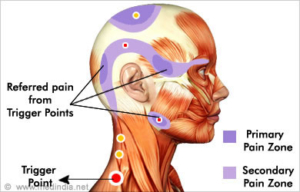Pain can come from many places in the body. Trigger points are one of them. Trigger points are tight tender knots in muscles. Sometimes they are called myofascial nodules or just myofascitis. They can cause a lot of pain. A classic sign is radiating pain, when you push on the nodule. Or in other words they cause pain in other areas than their location. Dr Janet Travell MD was famous for developing the understanding of trigger points. She became John F Kennedy’s personal doctor, because she helped relieve his back pain by treating his trigger points in his lower back.

Trigger points are usually caused by:
Joint problems such as subluxation (misaligned vertebrae) and arthritis
Accidents and Injuries
Lack of exercise
Bad posture -swayback posture, telephone posture, computer posture
Muscle overuse, repetitive micro-trauma, over exercising
Chronic stress – anxiety, depression, psychological stress trauma,
Nutrient deficiencies
Sleep disturbances
These factors lead to a local inflammatory response in the muscle, which leads to loss of oxygen supply, loss of blood and nutrient supply irritated nerves in the muscle itself, shortening of muscle fibers, scar tissue, and increased metabolic demand on local tissues.
Trigger points can occur in any muscle. But the most common areas are the neck, back and shoulders. This is because the nerves, joints and muscles of the spine are in constant communication. And when the vertebrae mis-align (subluxate) and pinch the nerves that sends signals directly to the muscles in the back, neck and shoulder areas. This causes the muscle to become irritated, tighten and eventually turn into trigger points. And then the muscle pain becomes a new source of pain and takes on a life of it’s own. Patients who come to my office know that I always work on the muscles as well as the spine on every visit. If you don’t take care of the muscles as well, you never achieve as good of success. I like to compare it to teenagers with cell phones. The joints, nerves and muscles are like BFFs. They are constantly texting (communicating) and if one is unhappy, the others are unhappy also.
How do you treat Trigger points? Dr Travell injected the trigger points. Some doctors still do. Most trigger points occur at the locations of acupuncture points. So acupuncturists will place a needle at that point. The most effective and easier method is to apply pressure for 10-30 seconds to the point. Often you will get shooting or radiating pain. But after you release the pressure, the pain will be diminished. Other techniques like IASTM, Graston Technique and transverse friction massage help with breaking down the scar tissue that develops in the trigger point. And, always, you need to exercise or the trigger point will reactivate. But none of these treatments will be as successful without adjusting the mis-alignments that cause pinched and irritated nerves in the first place.
